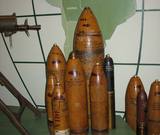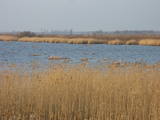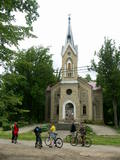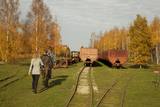| Nr | Nosaukums | Apraksts |
|---|---|---|
|
Ķemeru skolas ēkas būvniecība pabeigta 1934.
gadā (arhitekts K. Cināts). Tā ir viena no nedaudzajām
skolu ēkām Latvijā, kur saglabājies vēsturiski vērtīgs
interjers un eksterjers – t.sk. alegoriski tēli uz tās
fasādes.
|
||
|
Ventspils ir viena no attīstītākajām Latvijas pilsētām ar izcilu infrastruktūru, restaurētu vecpilsētu un Livonijas Ordeņa pili, tīru un labi ierīkotu balto smilšu pludmali, promenādi un dažādām izklaides un atpūtas vietām. Pilsēta ir piemērota ģimenēm, un bērni visvairāk izbauda Zilā karoga pludmali ar dažādām šūpolēm, slidkalniņiem, kā arī Bērnu pilsētiņu ar aktivitāšu zonām dažādu vecumu bērniem. Īss izbrauciens ar Mazbānīti, kas ir interesanta atrakcija gan bērniem, gan pieaugušajiem. Ūdens priekus var baudīt gan iekštelpu, gan āra akvaparkos. Dodieties izbraucienos pa tuvējo apkārtni, lai izbaudītu ainavisko jūras piekrasti, redzētu tradicionālos zvejnieku ciematus, kur iespējams iegādāties kūpinātas zivis tieši no zvejniekiem. Slīteres nacionālais parks ar skaistu skatu, kas paveres no Slīteres bākas, apburošā Kuldīga ar tās koka arhitektūru. |
||
|
Siguldas pils celtniecību uzsāka Zobenbrāļu ordenis 1207. g., bet 1236. g. to pārbūvēja Livonijas ordeņa vajadzībām. Siguldas pils stipri cieta 16. gs. otrās puses un 17. gs. sākuma karos. Ziemeļu kara laikā to nodedzina un vairāk neatjauno. Šodien ir apskatāms pils konventa ēkas dienvidrietumu korpuss un galveno vārtu tornis, aiz kura atrodas iekšējā priekšpils ar brīvdabas estrādi, no kuras paveras iespaidīgs skats uz Gaujas senleju. Dienvidos esošās Siguldas Jaunās pils celtniecība (īpašnieks - kņazs Kropotkins) norisinājās laikā no 1878. - 1881. g. No 1923. - 1940. g ēkā bija Rakstnieku pils, bet Padomju gados - kardioloģijas sanatorija. Kopš 2003. g. te atrodas Siguldas novada dome. Muižas kompleksā ir saglabājusies koka dzīvojamā ēka (19. gs. vidus), kurā atradās Kropotkina ģimenes mājas, klēts (18. - 19. gs. mija), dārznieka māja (19. gs.) un mūra žogs (19. gs.). Ja no Jaunās pils dosimies ziemeļaustrumu virzienā, pēc nepilniem 2 km nonāksim pie Vējupītes gravas. Tajā apskatāma seklā (3,6 m), bet augstā (6,1 m) Pētera ala un dziļā Pūču grava ar Kraukļupīti. Abu upīšu gravu saskares vietā paceļas Satezeles pilskalns (plakums 90 x 75 m), kur 13. gs. sākumā atradās līvu zemes vadoņa (vecākā) - Dabreļa ozolkoka pils. Netālu meklējama Kraukļu aiza - Vējupītes kreisā krasta sānu grava ar 11 m augstām smilšakmens sienām un 5,2 m dziļā Kraukļu ala. Vējupītes gravas un Gaujas senlejas saskares vietā slejas Paradīzes (Gleznotāju) kalns - ļoti ainaviska vieta, kas gleznota un fotografēta kopš seniem laikiem! Siguldas rietumdaļā var apmeklēt Panorāmas ratu (darbojas vasaras laikā) un Gaisa trošu ceļu (tramvajs) - Baltijas valstīs vienīgo (celts 1969. g.) šāda tipa transporta līdzekli. Tā nesošā trose stiepjas 1060 m garumā un bez atbalstiem savieno Gaujas senlejas krastus starp Siguldu un Krimuldu ~ 40 m augstumā virs Gaujas. Siguldas dienvidrietumu daļā var aizstaigāt līdz varenajai Beites kraujai, kuru pāršķeļ dziļa strauta grava. Gravas rietumu pusē meklējams Ķeizarskats, kas atrodas ~ 67 m virs Gaujas līmeņa ar labu skatu uz Krimuldu un Turaidas pili. Skatu vietu šeit iekārtoja jau 1862. g. kad Siguldā viesojies Krievijas cars Aleksandrs II. Gravas austrumu pusē novietots no koka veidotais Ķeizarkrēsls. Vietā, kur Gaujas senlejas labo pamatkrastu pāršķeļ vairākas mazu strautu dziļās gravas, izvietojies Turaidas muzejrezervāts ar Baltijas mērogā izciliem pieminekļiem, kuru vēsture iestiepjas 1000 gadu tālā pagātnē. Starp tiem ir jāmin Turaidas muiža (21 ēka), Turaidas Rozes kaps, Turaidas luterāņu baznīca (viena no vecākajām (1750. g.) Latvijas koka baznīcām) un Turaidas pils. Blakus esošajā Dainu kalnā tiek organizēti dažādi tematiski pasākumi. |
||
|
Jauka atpūta lauku mājā, kura atrodas 2 km no Aizkraukles pilsētas un 1,5 km no Aizkraukles dzelzceļa stacijas. Atpūtas komplekss ir piemērots atpūtai divatā vai draugu pulkā, līdz 25 cilvēku kompānijai. Brīvdienu mājā nakšņošanai ir paredzētas trīs atsevišķas istabiņas, kurās ir divvietīgās gultas. Var izmitināt līdz 16 cilvēkiem, uzklājot papildvietas. Atsevišķā ēkā ir viesību zāle ar pirti un kublu. Ir arī melnā pirts. Teritorijā ir telšu un treileru vietas. Aktīvai atpūtai ir velosipēdu noma, nūjošana, zirgu izjādes, zirglietu muzejs un mini zoodārzs. |
||
|
Briežuciems, kas atrodas Balvu novadā, ir izveidojies pēc 2. Pasaules kara kā padomju saimniecības „Briežuciems” centrālais ciemats. Mūsdienās Briežuciema amatu meistaru ciems ir vieta, kur tiek kopti un godāti tradicionālie amati, iesaistot tos mūsdienu dzīvē. |
||
|
Piedāvā makšķerēšanu piemājas piecos zivju dīķos un zivju žāvēšanu. Saimnieks gatavo karsti kūpinātas foreles, žāvētas karpas un uz ugunskura vāra zivju zupu. Vistu olu iegāde. |
||
|
Muzejs atrodas Pulvertornī, kas viduslaiku Rīgā bija nozīmīga pilsētas fortifikācijas sistēmas sastāvdaļa. Muzeja pamattēma ir Latvijas militāri – politiskā vēsture un ar to saistītie eksponāti.
|
||
|
Sekls, eitroficēts lagūnas tipa (senā Litorīnas jūras lagūna) ezers, kura aizaugums ir sasniedzis ~ 60 %. Dabas liegums veidots gan aizaugošā ezera, gan tās apkārtnes (mitras pļavas) biotopu un ligzdojošo putnu (ap 60 sugas) aizsardzībai. Ezera apskates nolūkos var izmantot dambju sistēmu tā dienvidu krastā. Populāra makšķerēšanas un putnu vērošanas vieta.
|
||
|
Enerģijas sēta Navesti upes krastā ir Igaunijas lielākais uzņēmums, kas nodarbojas ar ārstniecības augu audzēšanu, izmantojot dabai un cilvēka veselībai draudzīgas metodes. Apskatāmas ārstniecības augu mācību takas, moderna tējnīca, jauns semināru centrs kopā ar spa. |
||
|
This itinerary allows you to enjoy the Latvian winter at its best. It starts in the bustling capital of Riga with its Christmas market, decorations, shopping facilities, many cultural events and museums as well as a charming Old Town. |
||
|
Uzcelts Kaņiera pilskalnā un ir Kaņiera pilskalna takas sastāvdaļa. No torņa paveras izcila Kaņiera ezera dienvidrietumu daļas ainava ar niedru saliņām un nelieliem atklāta ūdens laukumiem. Laba putnu vērošanas vieta. |
||
|
Arī Karaļa vārti (Kuningavärav). Baroka stila celtne ir neliela daļa no Pärnu viduslaiku nocietinājumu sistēmas, kas saglabājusies. Senā pasta ceļa sākums. |
||
|
Restorāns atrodas pusstundas braucienā no Madonas."Vakars uz Ezera" ir ekskluzīva iespēja vakariņot īpaši - uz ūdens, Kālezera vidū, izbaudot saulesrietu. Katrā "Vakars uz Ezera" vakariņošanas reizē tiek izvēlēti citi pavāri. |
||
|
Alūksnes novada saimniecībā "Pauguri" kokamatnieks Jānis Vīksne izgatavo koka virpojumus - cibiņas, pulksteņus, pildspalvas, spēles, šūpoles un citas saimniecībā noderīgas lietas. Iespējams iegādāties kokamatniecības suvenīrus - dekoratīvus un praktiskus virpojumus no koka. Senlietu muzeja apskate - seni galdniecības darba galdi, ēveles, āmuri, sirpji, grābekļi, sējmašīna, pulksteņi, trauki u.c. Saimniecībā ir izveidota skatu platforma, no kuras paveras skats uz Hānjas augstienes ainavām Igaunijā, kā arī atpūtas vieta vasaras piknikam ar galdu, uguskura vietu un skulptūrām. |
||
|
Kafejnīca "Express Pizza" atrodas tirdzniecības centrā „Oga”, izbraucot no Preiļiem Līvānu virzienā. Piedāvā sierus, kas ir pilsētas „vizītkarte”. Kafejnīcā ir divas ēdināšanas zonas ar kopēju ēdamzāli: vienā zonā latviešu tradicionālie ēdieni un kūkas, otrā – picas. Latviešu virtuve: „Preiļu kļockas”, „Preiļu siera zupa” un siera kūka. |
||
|
A. Upīša ielā 18. Baznīca celta 1897. g. neogotikas formās (arhitekts H. Šēls) un tā ir viena no nedaudzajām 19. gs. pilsētas ķieģeļu ēkām. Dievnamā atrodas I. Zeberiņa altārglezna “Kristus izdziedina slimos” (1943. g.). Baznīcu no iekšpuses var apskatīt dievkalpojumu laikā, vai iepriekš piesakoties. Pie baznīcas apskatāms E. Laubes projektēts piemineklis (1926. g.) 80 latviešu strēlniekiem, kuri krituši 1. pasaules karā un apglabāti tuvāk Vēršupītei esošajos Brāļu kapos. Pie baznīcas apglabāti arī 1919. g. 18. maija Kauguru kaujas dalībnieki J. Kārkliņš un F. Siliņš. Iepriekš piesakoties, tūristu grupas baznīcu var apskatīt no iekšpuses. |
||
|
Labumu bode ir ģimenes uzņēmums - veikaliņš Ikšķilē, kur iespējams iegādāties Latvijas mazo ražotāju un amatnieku radītos produktus. Veikalu ir iemīļojuši ne tikai Ikšķiles un tuvākās apkārtnes iedzīvotāji, bet arī pircēji no Rīgas, Ķekavas, Ogres un citām pilsētām, tāpēc izveidots arī internetveikals. |
||
|
Sedas purva kājnieku maršruts atrodas dabas liegumā Sedas purvs, pārgājienu pa maršrutu iespējams apvienot ar Sedas pilsētas apskati, kas ir unikāls 20.gs. 50.–60. gadu pilsētbūvniecības un arhitektūras paraugs - kūdras purva strādnieku pilsēta. Maršrutam ir divi apļi - Jērcēnu aplis - 5,5 km un Sedas aplis - 4,2 km. Tajos apakatāms izstrādātais kūdras purvs, šaursliežu dzelzceļš, ritošais sastāvs, divi skatu toņi. Rudenī un pavasarī - putnu migrācijas lāikā - interesanta vieta putnu vērošanai. GPS koordinātes: Jērcēnu puses aplim: 57.7055987, 25.7001324; Sedas puses aplim: 57.6699587, 25.7514815. |
||
|
Atrodas 50 m rietumos no Ludzas katoļu baznīcas. Kapela celta 1738. g. astoņskaldņu rotondas formā un kalpoja kā grāfu Karņicku atdusas vieta (velvēti pagrabi zem kapelas). Nelielai ēkai ir dēļu apšuvums, koka griesti un ķieģeļu grīda. Pie kapelas novietota Ludzas mākslinieka Leona Tomašicka 1934. g. darinātā Svētās Marijas - Māras zemes karalienes statuja. |
||
|
Pērnavas viduslaiku nocietinājumu mūra stūra tornis. Tā pagalms – populāra suvenīru tirdzniecības un pasākumu norises vieta. |
||





























